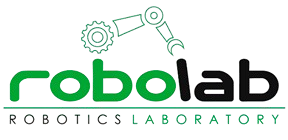Publicaciones
2024
2021
2020
- Araceli Vega, Calderita Estevez, Bustos Garcia, Núñez Trujillo | Human-aware Robot Navigation based on Time-dependent Social Interaction Spaces a use case for assistive robotics


- Bachiller Burgos, Barbecho Delgado, Calderita Estevez, Bustos Garcia | LearnBlock A Robot-Agnostic Educational Programming Tool


- Calderita Estevez, Vega, Barroso-Ramirez, Bustos Garcia | Designing a Cyber-Physical System for Ambient Assisted Living A Use-Case Analysis for Social Robot Navigation in Caregiving Centers


- Calderita, Vega, Bustos Garcia, Núñez Trujillo | Social Robot Navigation adapted to Time-dependent Affordance Spaces a Use Case for Caregiving Centers


- Manso Arguelles, Núñez Trujillo, Calderita Estevez, Faria | SocNav1 A Dataset to Benchmark and Learn Social Navigation Conventions


2017
2016
2015
- Calderita Estevez, Bustos Garcia | Deep State Representation an Unified Internal Representation for the Robotics Cognitive Architecture CORTEX


- Calderita Estevez, Bustos Garcia, Suarez Mejias, Fernandez | Asistente robotico socialmente interactivo para terapias de rehabilitacion motriz con pacientes de pediatria


- Romero-Garces, Calderita Estevez, Martinez-Gomez, Bandera | Testing a fully autonomous robotic salesman in real scenarios


- Romero-Garces, Calderita Estevez, Martinez-Gomez, Bandera | The cognitive architecture of a robotic salesman


2014
- Calderita Estevez, Bandera, Manso Arguelles | 3D laser from RGBD projections in robot local navigation


- Calderita Estevez, Bustos Garcia, Suarez Mejias, Fernandez | THERAPISTTowards an autonomous socially interactive robot for motor and neurorehabilitation therapies for children


- Manso Arguelles, Calderita Estevez, Bustos Garcia, Garc | A General-Purpose Architecture to Control Mobile Robots


- Martinez-Gomez, Marfil, Calderita Estevez, Bandera | Toward Social Cognition in Robotics Extracting and Internalizing Meaning from Perception


2013
- Calderita Estevez, Bandera, Bustos Garcia, Skiadopoulos | Model-based reinforcement of Kinect depth data for human motion capture applications


- Calderita Estevez, Bustos Garcia, Suarez Mejias, Ferrer Gonzalez | Rehabilitation for children while playing with a robotic assistant in a serious game


- Doblado, Mogena, Cid Burgos, Calderita Estevez | RGB-D Database for Affective Multimodal Human-Robot Interaction


2012
2011
- Bustos Garcia, Calderita Estevez, Cintas Pena, Bachiller Burgos | Design of a Social Robot as assistant to training children with motor impairments


- Calderita Estevez, Bachiller Burgos, Bandera, Bustos Garcia | MIMIC A Human motion imitation component for RoboComp


- Cid Burgos, Cintas Pena, Manso Arguelles, Calderita Estevez | A real-time synchronization algorithm between Text-To-Speech TTS system and Robot Mouth for Social Robotic Applications


2010

Luis Vicente Calderita Estévez
Profesor Contratado Doctor
